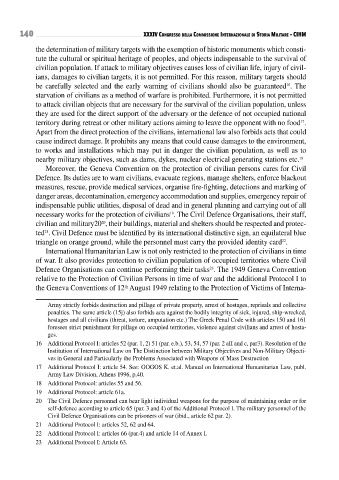Page 140 - Conflitti Militari e Popolazioni Civili - Tomo I
P. 140
140 XXXIV Congresso della CommIssIone InternazIonale dI storIa mIlItare • CIHm
the determination of military targets with the exemption of historic monuments which consti-
tute the cultural or spiritual heritage of peoples, and objects indispensable to the survival of
civilian population. If attack to military objectives causes loss of civilian life, injury of civil-
ians, damages to civilian targets, it is not permitted. For this reason, military targets should
be carefully selected and the early warning of civilians should also be guaranteed . the
16
starvation of civilians as a method of warfare is prohibited. Furthermore, it is not permitted
to attack civilian objects that are necessary for the survival of the civilian population, unless
they are used for the direct support of the adversary or the defence of not occupied national
territory during retreat or other military actions aiming to leave the opponent with no food .
17
Apart from the direct protection of the civilians, international law also forbids acts that could
cause indirect damage. It prohibits any means that could cause damages to the environment,
to works and installations which may put in danger the civilian population, as well as to
nearby military objectives, such as dams, dykes, nuclear electrical generating stations etc.
18
Moreover, the Geneva Convention on the protection of civilian persons cares for Civil
Defence. Its duties are to warn civilians, evacuate regions, manage shelters, enforce blackout
measures, rescue, provide medical services, organise fire-fighting, detections and marking of
danger areas, decontamination, emergency accommodation and supplies, emergency repair of
indispensable public utilities, disposal of dead and in general planning and carrying out of all
necessary works for the protection of civilians . The Civil Defence Organisations, their staff,
19
civilian and military20 , their buildings, material and shelters should be respected and protec-
20
ted . Civil Defence must be identified by its international distinctive sign, an equilateral blue
21
triangle on orange ground, while the personnel must carry the provided identity card .
22
International Humanitarian Law is not only restricted to the protection of civilians in time
of war. It also provides protection to civilian population of occupied territories where Civil
Defence Organisations can continue performing their tasks . The 1949 Geneva Convention
23
relative to the Protection of Civilian Persons in time of war and the additional Protocol I to
the Geneva Conventions of 12 August 1949 relating to the Protection of Victims of Interna-
th
Army strictly forbids destruction and pillage of private property, arrest of hostages, reprisals and collective
penalties. The same article (15j) also forbids acts against the bodily integrity of sick, injured, ship-wrecked,
hostages and all civilians (threat, torture, amputation etc.) The Greek Penal Code with articles 150 and 161
foresees strict punishment for pillage on occupied territories, violence against civilians and arrest of hosta-
ges.
16 Additional Protocol I: articles 52 (par. 1, 2) 51 (par. e.b.), 53, 54, 57 (par. 2 aII and c, par3). Resolution of the
Institution of International Law on The Distinction between Military Objectives and Non-Military Objecti-
ves in General and Particularly the Problems Associated with Weapons of Mass Destruction
17 Additional Protocol I: article 54. See: GOGOS K. et.al. Manual on International Humanitarian Law, publ.
Army Law Division, Athens 1996, p.40.
18 Additional Protocol: articles 55 and 56.
19 Additional Protocol: article 61a.
20 The Civil Defence personnel can bear light individual weapons for the purpose of maintaining order or for
self-defence according to article 65 (par. 3 and 4) of the Additional Protocol I. The military personnel of the
Civil Defence Organisations can be prisoners of war (ibid., article 62 par. 2).
21 Additional Protocol I: articles 52, 62 and 64.
22 Additional Protocol I: articles 66 (par.4) and article 14 of Annex I.
23 Additional Protocol I: Article 63.

